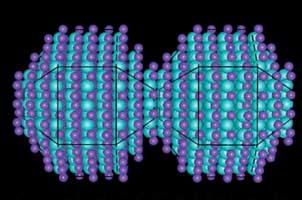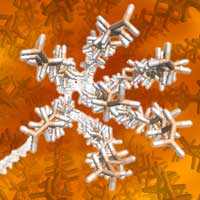 Gold nanoparticles, which are supposed to be stable in biological environments, can be degraded inside cells.
Gold nanoparticles, which are supposed to be stable in biological environments, can be degraded inside cells.
Monday, December 16, 2019
What happens to gold nanoparticles in cells?
 Gold nanoparticles, which are supposed to be stable in biological environments, can be degraded inside cells.
Gold nanoparticles, which are supposed to be stable in biological environments, can be degraded inside cells.
Mind the gap - new wide-bandgap topological insulator
 Researchers have discovered a 'telephone number' compound combining wide bandgap and robust topological surface state, which could enable room-temperature operation of ultra-energy efficient electronics.
Researchers have discovered a 'telephone number' compound combining wide bandgap and robust topological surface state, which could enable room-temperature operation of ultra-energy efficient electronics.
New discovery reveals tractionless motion is possible
 Sientists have answered the fundamental question: 'Is it possible to move without exerting force on the environment?', by describing the tractionless self-propulsion of active matter.
Sientists have answered the fundamental question: 'Is it possible to move without exerting force on the environment?', by describing the tractionless self-propulsion of active matter.
Artificial intelligence may help scientists make spray-on solar cells
 Artificial Intelligence may be just the thing to accelerate spray-on solar cell technology, which could revolutionize how consumers use energy. A research team used Machine Learning, aka Artificial Intelligence to optimize the materials used to make perovskite solar cells.
Artificial Intelligence may be just the thing to accelerate spray-on solar cell technology, which could revolutionize how consumers use energy. A research team used Machine Learning, aka Artificial Intelligence to optimize the materials used to make perovskite solar cells.
How we transport water in our bodies inspires new water filtration method
 A multidisciplinary group of engineers and scientists has discovered a new method for water filtration that could have implications for a variety of technologies, such as desalination plants, breathable and protective fabrics, and carbon capture in gas separations.
A multidisciplinary group of engineers and scientists has discovered a new method for water filtration that could have implications for a variety of technologies, such as desalination plants, breathable and protective fabrics, and carbon capture in gas separations.
A new tool tidies up molecules at the nano level
 A new study reports the design of new, artificial cellular parts that can organize, 'tidy up', targeted molecules inside living cells.
A new study reports the design of new, artificial cellular parts that can organize, 'tidy up', targeted molecules inside living cells.
Researchers combine quantum dot 'atoms' and create new 'molecules'
 Scientists developed a method that enables quantum dots to join together and form new molecular structures.
Scientists developed a method that enables quantum dots to join together and form new molecular structures.
More efficient risk assessment for nanomaterials
 Researchers analyse biological mechanisms of action and identify biomarkers.
Researchers analyse biological mechanisms of action and identify biomarkers.
Growing carbon nanotubes with the right twist
 Researchers synthetize nanotubes with a specific structure expanding previous theories on carbon nanotube growth.
Researchers synthetize nanotubes with a specific structure expanding previous theories on carbon nanotube growth.
Creating a nanoscale on-off switch for heat
 Polymer thermal regulator transforms from conductor to insulator and back again.
Polymer thermal regulator transforms from conductor to insulator and back again.
Looking inside 3D silicon nanostructures without leaving a trace: 'the Good, the Bad, the Ugly'
 Scientists have discovered a new method to non-destructively look inside three-dimensional (3D) nanostructures without breaking them. The study is timely since 3D nanostructures are drawing a fast-growing attention for their advanced functionalities in nanophotonics, photovoltaics, 3D integrated circuits, and flash memories.
Scientists have discovered a new method to non-destructively look inside three-dimensional (3D) nanostructures without breaking them. The study is timely since 3D nanostructures are drawing a fast-growing attention for their advanced functionalities in nanophotonics, photovoltaics, 3D integrated circuits, and flash memories.
Subscribe to:
Posts (Atom)
